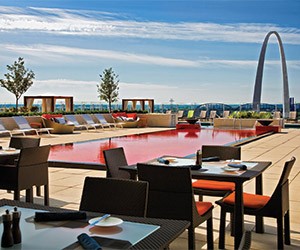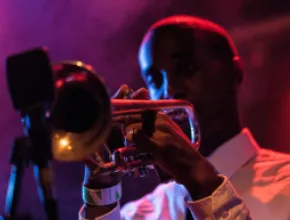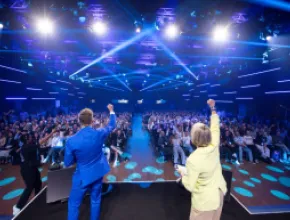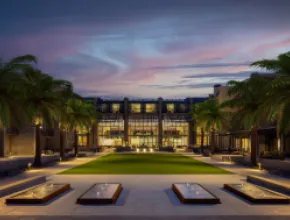St. Louis, aka the Gateway City, holds a remarkable place in the history of the U.S., both as the kickoff point for the westward expansion of the nation and as a Midwestern manufacturing powerhouse that stood toe to toe with Chicago for much of the 19th century and into the 20th.
Legacy companies that started in St. Louis are household names, such as Anheuser-Busch, Ralston Purina, Monsanto and Edward Jones Financial, the latter or which still makes the city a player in the global financial services market. Washington University in St. Louis, one of the top medical research schools in the world and founded in 1853, is a beacon drawing some of the most prominent medical minds in the world, with an Ivy League setting that has launched some 25 Nobel laureates throughout its history.
But the focus these days is on the new, as in new industries and even a new Gateway Arch, in some respects. St. Louis is a modern Rust Belt city on the move into a new century and global economy, with all of the meetings and conventions facilities and amenities to match. And as the icing on the proverbial cake, St. Louis benefits from a wealth of no-cost attractions, including the Saint Louis Zoo, giving it the distinction of offering the most free attractions of any U.S. city outside of Washington, D.C.
“If meeting professionals haven’t taken a close look at St. Louis in the last couple years, they’re missing a real opportunity to see a community that’s been really transformed, and has a lot of new attractions and amenities that make this a great meetings destination,” said Brian Hall, chief marketing officer at the St. Louis Convention & Visitors Commission. “We’ve had $6 billion in investment in the urban core over the last decade.”
Meetings Today got a chance to tour the city in late March 2017, and discovered that St. Louis is indeed ready for its close-up, with a freshened collection of hotels located near its super-functional America’s Center convention facility, optimal off-site options for sports- and music-themed events, and substantial investment continuing to stoke the development of a massive district fueling innovation in the biomedical segment.
It’s a mix of old and new, tried-and-true and yet-to-be-proven in a city that was built on brick, mortar and heavy industry but is rowing together as a team as River City pushes forward into a new future.
And even the legacy companies have a central role in the play.
“There are many legacy firms in St. Louis, like Ralston Purina and Monsanto, that are also at the cutting edge of this innovation,” Hall said, describing emerging tech, agriculture and bio-medical incubators in the new Cortex Innovation Community district and Donald Danforth Plant Science Center on the edge of town, anchoring another incoming business development. “So they’re hand-in-glove with a lot of the new innovators that are coming in to form these new companies. Purina actually has a team that is working in one of the high-tech incubators downtown, Boeing is in an incubator in midtown and Monsanto is very active at the Danforth Plant Science Center. We’re fundamentally shaping our future through innovation and entrepreneurship.”
At the same time, much of the historic brick and stone building stock that defined the city in the 19th and early 20th centuries has been preserved and offers a solid foundation for meeting venues.
Having only been around for a mere half-century, the city’s iconic Gateway Arch may not quite be a “legacy” attraction, but it’s certainly what most people have in their mind’s eye when they think of St. Louis. Fitting its standing, the massive $380 million CityArchRiver project (See “Arch of Triumph” sidebar) is transforming the monument’s grounds to allow unfettered access to the public along with substantial design improvements and facility upgrades that will be in tune with meeting group needs.
“The Arch transformation is a game-changer for St. Louis,” Hall said. “This $380 million investment will bring us a new state-of-the-art Museum of Western Expansion, new grounds and better connectivity between the city and the river. People that came before will want to come back and see the change.”
Other standouts on our trip included the Cathedral Basilica of Saint Louis, which defies superlatives with its all-consuming ceiling mosaics that were begun in 1912 and not finished until 1988. Its 83,000 square feet of glass mosaic tiles are the largest collection of its kind in the world, and worth at least a stop to immerse a group in one of the most beautiful churches anywhere in the world.
The Convention Center
The recently renovated America’s Center Convention Complex, located in the heart of downtown and connected to the former NFL Rams’ domed stadium, offers a multitude of venues that combine for maximum meeting flexibility.
The 502,000-square-foot facility includes 80 meeting rooms, a 28,000-square-foot ballroom, the 1,400-seat Ferrara Theatre and five exhibit halls.
“We have half-a-million square feet of functional, contiguous exhibit space, which is very feasible for large events, especially since it’s connected to the domed stadium. We can seat up to 35,000 people for a general session,” Hall said of the former home of the NFL Rams, now named The Dome at America’s Center.
PageBreak
“We have a host of new food options right outside of our doors,” he continued, “ranging from barbecue to Italian to American continental, and the majority of the restaurants in immediate proximity to America’s Center are one-of-a-kind restaurants.”
The Hotels
St. Louis offers 7,000 hotel rooms downtown, with many close to America’s Center.
“We have a fantastic assortment of both branded and independent hotel rooms,” Hall said. “Many of the hotels in downtown St. Louis have experienced recent improvements, including the Marriott St. Louis Grand, the St. Louis Union Station Hotel and the Hyatt Regency St. Louis at The Arch, and we have a couple of new entrants, including the Magnolia Hotel St. Louis boutique hotel just steps from the America’s Center and the Courtyard St. Louis Downtown/Convention Center, which is immediately adjacent to the America’s Center.”
Select hotels toured on our visit to St. Louis included the following.
Hilton St. Louis at the Ballpark
This 670-room property across the street from Busch Stadium features 45,000 square feet of meeting space that can host up to 1,460 attendees. Prime offerings include close proximity to St. Louis Ballpark Village, with its scores of restaurants, bars and entertainment options, and its 360 Rooftop Bar at Hilton Ballpark, a 6,000-square-foot indoor/outdoor event option that boasts panoramic views of downtown, the Gateway Arch, the Mississippi River and the home of the Cardinals.
Magnolia Hotel St. Louis
The former Mayfair Hotel, opened in 1925, the Magnolia provides a sophisticated setting for groups, with a casual “living room” space featuring antique stained-glass windows right off the entrance and Tiffany chandeliers off the lobby that came from the previous owners of the property, who owned the original Aladdin Hotel in Las Vegas. Another highlight is the Cary Grant Suite, honoring the famed late actor and frequent guest with decorations and artifacts from his storied career. The hotel, in fact, was the first place where that somewhat standard hotel amenity, chocolates left on the pillow—a play by the suave Grant to cozy up to a female guest—originated. Located a block from America’s Center, the Starwood-managed Tribute Portfolio boutique property emerged from a renovation in 2014 that brought down its room count from 400 to 182, with 162 suites and 60 king rooms. Its Magnolia ballroom has a capacity for 250 and benefits from a tree-filled view of the Old Post Office Plaza.
Marriott St. Louis Grand Hotel
The largest hotel near the convention center, the 917-room Marriott St. Louis Grand Hotel started life as the Statler Hotel in 1917, and finished a $200 million-plus renovation in July 2015. With an emphasis on offering high-tech amenities, every guest room features an array of device plug-ins and ports and a Netflix-enabled entertainment center, and the hotel bumped up its bandwidth from 100 MBPS to an impressive 1,000 MBPS during the renovation. The property’s 75,000 square feet of meeting space features the 20,000-square-foot Crystal Ballroom, dating to 1917, and the Statler Ballroom, for up to 200.
Courtyard by Marriott St. Louis Downtown Convention Center
This is not your father’s Courtyard by Marriott. This historic 162-room property, built in the 1920s, finished a $40 million renovation two years ago that resulted in all rooms measuring 450 square feet or more, along with a Netflix-enabled entertainment center. Its second-floor boardroom seats up to 15 and the Lennox meeting room can accommodate up to 40. Many planning teams meeting at the nearby America’s Center use this property as the headquarters for their convention operation, and because it’s privately held, the hotel prides itself on offering a high degree of flexibility for its group clients.
Four Seasons Hotel St. Louis
Groups craving the understated elegance of one of the foremost luxury hotel brands, but without the high price Four Seasons typically demands at some of its top-tier hotels and resorts, can drink in impressive views of the Gateway Arch from this refined property located near the confluence of the Mississippi and Missouri rivers. This 200-room hotel—with half of its rooms offering Gateway Arch views—is attached to the only casino in St. Louis, the Lumiere Place Casino and its sister property the Hotelumiere at The Arch, and offers the 7,300-square-foot Mississippi Ballroom overlooking the iconic river. The dynamic 25,000-square-foot Sky Terrace boasts jaw-dropping views of the Arch and the Laclede’s Landing historic entertainment district just outside its front door.
St. Louis Union Station Hotel, Curio Collection by Hilton
Located just outside the downtown core, this sprawling AAA Four Diamond historic property started out as the city’s primary rail station, Union Station, which at its height was the largest and busiest train station in the world. It serves its historic past superbly, being loaded with vintage train travel decor, and groups can even rent historic rail cars to depart from the hotel for 1.5-hour city tours. Maybe the coolest part of this property is the Grand Hall Experience 3D Light Show, which fills its ornate, original entrance with intricate light show programming that bounces off the arched ceilings of the expansive lobby. The lobby features a long bar and makes for a prime space for a reception or other F&B-focused events that will leave attendees awe-struck by the dancing lights and booming music. The property offers 100,000 square feet of flexible meeting space—the second most in the city after America’s Center, for up to 2,000. A massive renovation of its event space—located in the old terminal where the cars used to come in—will add 43,000 square feet of space upon completion and offer numerous entertainment and shopping options.







